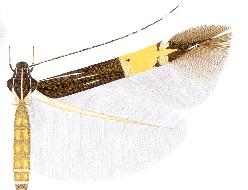Cosmopterix attenuatella facts for kids
Quick facts for kids Cosmopterix attenuatella |
|
|---|---|
 |
|
 |
|
| Scientific classification | |
| Kingdom: | |
| Phylum: | |
| Class: | |
| Order: | |
| Family: |
Cosmopterigidae
|
| Genus: |
Cosmopterix
|
| Species: |
C. attenuatella
|
| Binomial name | |
| Cosmopterix attenuatella (Walker, 1864)
|
|
| Synonyms | |
|
|
Cosmopterix attenuatella is a tiny moth that belongs to a group called Cosmopterigidae. A scientist named Francis Walker first described it in 1864. This moth lives in many warm parts of the world. You can find it in both older regions like Africa and Asia, and newer regions like North and South America.
Contents
Discovering the Cosmopterix attenuatella Moth
Where Does This Moth Live?
This small moth is found all over the world in tropical and subtropical areas. This means it lives in warm places near the equator. You can find it in the United States and islands like Bermuda. It also lives in the Cayman Islands, Virgin Islands, and Puerto Rico. In South America, it's found in Brazil, Ecuador, Peru, and Argentina. Farther away, it lives in the Canary Islands, Australia, New Zealand, and Madagascar.
What Does This Moth Look Like?
The Cosmopterix attenuatella moth is quite small. Its wingspan is about 9 millimeters. That's less than half an inch! This tiny size helps it blend in with its surroundings.
Life Cycle and Food
These moths have an interesting life cycle. In warmer tropical areas, you can find adult moths all year long. In slightly cooler, but still warm, places, there are usually two generations of moths each year. This means they complete their life cycle twice.
The young moths, called larvae, are very particular about what they eat. They feed on certain types of plants. These include grasses from the Poaceae family, like Melinus minutiflora. They also eat Cyperus rotundus and different kinds of Scirpus plants.
How Larvae Eat Plants
The larvae are known as leaf miners. This means they tunnel inside the leaves of their host plants. Their tunnels look like a blotch or a spot on the leaf. This blotch starts near the tip of the leaf and spreads across its whole width.
As the larvae eat, the older parts of their mine turn brown and shrivel up. The newer parts, where they are currently eating, stay yellow. The waste material from the larvae, called frass, is black.
Pupation
When a larva is ready to change into an adult moth, it goes through a process called pupation. It forms a long, white cocoon. This cocoon is usually found right inside the leaf mine where the larva was living. After a period of time in the cocoon, the adult moth emerges.

